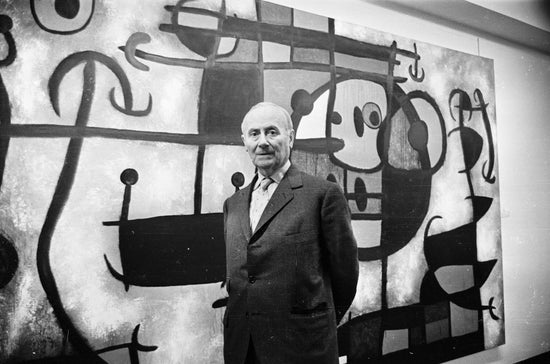
Joan Miró
Considered one of the leading surrealists, Joan Miró was a pioneer in the spontaneous drawing method that tried to express the inner workings of the human mind. His works were full of color and form and abstract elements such as birds, eyes and the moon. Currently, Miró's works break records at auction, an example of this was the painting “Red Hat Woman” which was sold at Sotheby's for around 24.5 million euros. In addition, his sculptures and public murals can be found in several cities around the world, including Milan, Paris and Barcelona. It is also possible to see his pieces in the collections of various institutions around the world, such as the Art Institute of Chicago and the Museum of Modern Art, among others.
Who was Joan Miro?
the surrealist painter Joan Miró was born in Barcelona, in 1893. From an early age he showed an interest in the plastic arts, since at the age of seven he was already attending painting classes. Early in his career, he was influenced by movements such as Fauvism and Dadaism, creating landscape paintings with intense brushstrokes, portraits and still lifes. An example of this is the work “Portrait of Enric Cristofol Ricart” (1917) where the influences of Van Gogh, Rousseau and Pablo Picasso.

“Portrait of Enric Cristòfol Ricart” (1917)
However, after the first exhibition in 1918, his compositions became increasingly direct and clear with an increased interest in line, form and structure. In 1920, he visited Paris, where he lived with avant-garde artists who inspired him in semi-realistic and semi-cubist representations, as we can analyze in the painting “The Farm” (1921). He continued to painstakingly paint the objects, while planning the linear space of the composition with geometric shapes and pigment stretching.

"The Farm" (1921)
Joan Miró and surrealism
In 1924, the French poet André Breton wrote the Manifesto of Surrealism, thus cementing one of the most important movements of the 20th century. In this manifesto, the poet claimed some of the main avant-garde artists of the period, including the name of Joan Miró. Between 1924 and 1927, while sharing a studio with André Masson and Max Ernst, he created a series of works that he dubbed painting-poetry, which consisted of words and inkblots, as in the painting “Le corps de ma brune…” (1925).

“Le corps de ma brune…” (1925)
The war
In the dangerous and catastrophic climate of the Second World War, Joan Miró created the Constellations, a series of twenty-three gouaches on paper, distinguished by their distinct visual vocabulary about the cosmic and the terrestrial. About this series the artist said:
"I had always enjoyed looking out of the windows at night and seeing the sky and the stars and the moon, but now we weren't allowed to do this any more, so I painted the windows blue and I took my brushes and paint, and that was the beginning of the Constellations."
These paintings, with shapes that move in a smoky setting, establish a relationship with the birds that fly over the bombings during the war. The complexity of these works expresses the artist's desire to flee and escape the horrors of war.

"The beautiful bird deciphering the unknown to a couple of loverss" (1941)
international career
After the war, he settled temporarily in Mallorca and achieved international recognition by continuing to experiment with new means of production, which reached the general public as ceramics, engraving, book illustration and sculpture. In 1954, he won the Grand Prix for Engraving at the Venice Biennale and in 1964, the Maeght Foundation was created in his honor in Saint-Paul-de-Vence.
In 1977, he painted “The Garden”, a work where we find several species of birds and surrealist flowers with a blue sky in the background and a star above the birds. From these intensely colored figures that emerge from a fantasy world, practically all the characteristics present in all of his works can be identified. At the end of his life, his works began to be reduced to elements such as dots and lines, and basically started to use black and white. Until the date of his death, on December 25, 1983, Joan Miró worked exhaustively. Discover the works of the fantastic Joan Miró on P55.

"The garden" (1977)
